CoreLogic data showed national average home price growth slowed to 0.6% in November, down from 0.8% in October and well down from the peak of 1.2% in May.
After 10 months of gains in a row momentum national home prices have risen to a record high, fully recovering from last year’s slump.
Brisbane, Adelaide and Perth are all at record highs, other cities and regional areas are all lagging.
However, the housing market is clearly slowing again as high interest rates with the prospect of more rate hikes to come impact.
This is particularly evident in a fall in prices in Melbourne and a sharp slowdown in gains in Sydney with falls evident in the last week or so.
With high interest rates getting the upper hand again we now expect national average prices to fall around 5% next year led by falls in Sydney and Melbourne.
Australian dwelling price growth Source: CoreLogicNational home price gains slowing sharply
Source: CoreLogicNational home price gains slowing sharplyCoreLogic national average home price data show a 8.3% rise from their January low taking them to a new record high. The rebound this year has been driven by an undersupply of property in the face of surging immigration levels, buyers who are not so interest rate sensitive seeking to take advantage of last year's price falls, some renters seeking to buy rather than pay significantly higher rents, the strong jobs market helping to minimise mortgage stress and a fear of missing out.
Taken together this swamped the impact of high and still rising interest rates and national property prices look on track for a gain of around 8% this year and 11% in Sydney.
However, this appears to be starting to change as monthly property price growth has slowed sharply from its May high of 1.2%mom, with prices actually falling in Melbourne, Hobart and Darwin last month and in Sydney in the last week. While Brisbane, Adelaide and Perth are still booming its noteworthy that they often lag swings in Sydney.
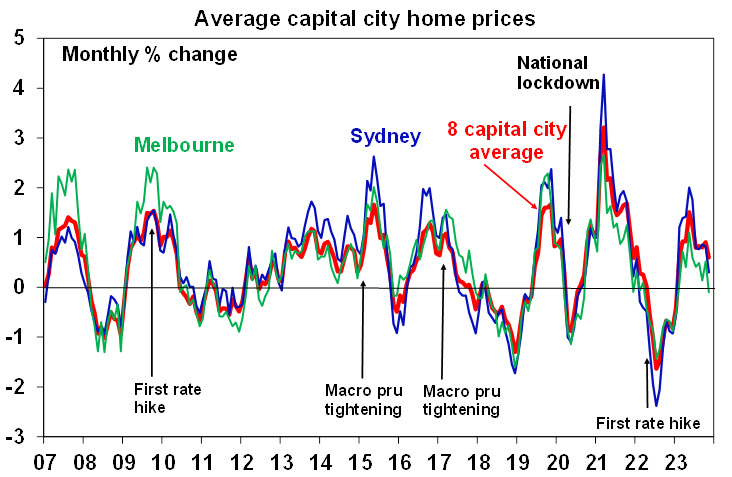 Source: CoreLogic, AMPHeading for a “double dip” - we now expect property prices to fall 5% next year, revised from a 5% gain
Source: CoreLogic, AMPHeading for a “double dip” - we now expect property prices to fall 5% next year, revised from a 5% gainWhile we had been looking for a further rise in property prices next year, we have been concerned for some time that the rise in property prices has run ahead of itself with a high risk of another leg down. With momentum slowing sharply this now appears to be starting to unfold and as such we have revised down our home price forecasts.
On the one hand the chronic housing undersupply in the face of record immigration numbers remains a strong force pushing home prices higher. But against this, the impact of high and potentially still rising mortgage rates is still feeding through and unemployment is likely to rise significantly over the next year.
- Even if rates have peaked, the huge hit to home buyer “capacity to pay” remains in place – we estimate that the capacity to pay for a home for a borrower with a 20% deposit on full time average earnings is around 30% lower than it was in April last year. The rapid reversal in the capacity to pay since May last year due to the surge in mortgage rates threatens a downwards adjustment in home prices at some point unless incomes rise dramatically or mortgage rates fall dramatically – both of which look unlikely. The reduction in capacity to pay this year may have been masked by buyers who were less interest sensitive – eg because they already had big deposits saved up or could rely on the back of mum and dad – but its likely that this pool of buyers is now running low.
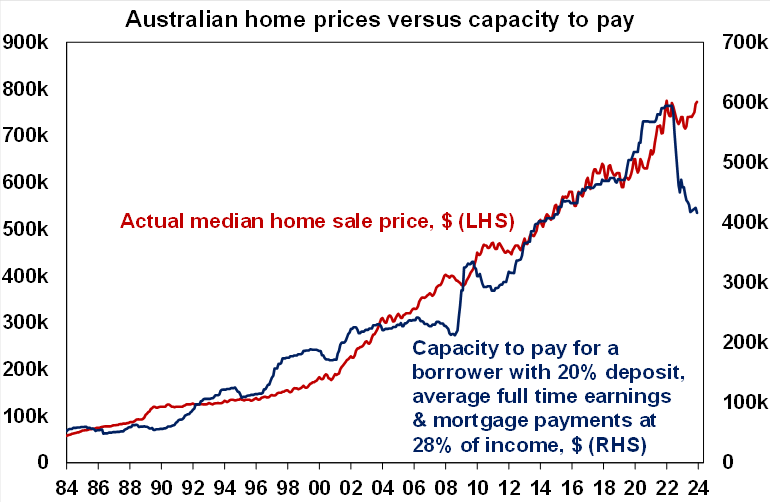 Source: RBA, CoreLogic, AMP
Source: RBA, CoreLogic, AMP- While lower than expected inflation for October has likely headed off a December rate hike, recent commentary from the RBA is clearly hawkish warning of a still high risk of even higher rates ahead.
- New listings have been trending up and there is a high risk of increased listings by distressed sellers – based on the RBA’s own analysis roughly one in seven home borrowers were cash flow negative (where income is less than essential living and mortgage costs) as at July and this is likely now higher. The pressure on household budgets this implies is immense and means sharp spending cutbacks (which runs the risk of significantly higher unemployment). Directly or indirectly (via the impact of higher unemployment) its hard to see this not leading to a further increase in listings.
- In the last three major cyclical upswings in home prices, lower interest rates have been required to drive a sustained rise in home prices and this is still a fair way off. So, the rebound in home prices so far this year looks premature relative to the normal cyclical relationship with interest rates.
- Related to this, consumer sentiment remains very depressed with sentiment towards buying a dwelling is very weak and pointing to home price weakness, in contrast to this year’s strength.
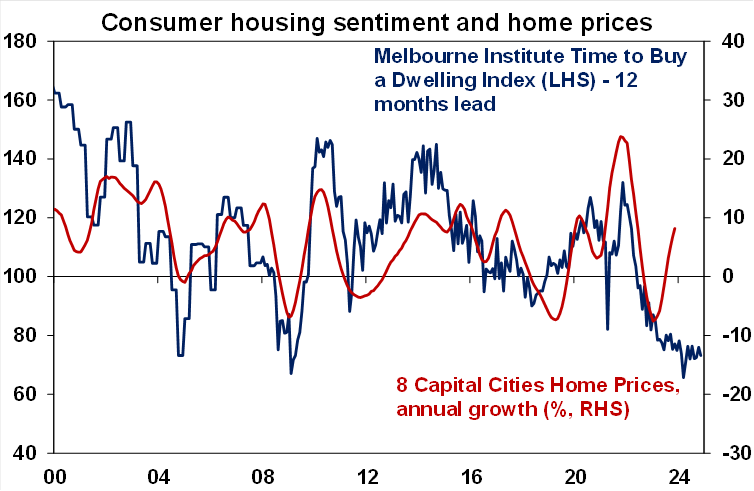 Source: Westpac/Melbourne Institute, CoreLogic, AMP
Source: Westpac/Melbourne Institute, CoreLogic, AMP- While the housing shortage will continue to worsen, it’s likely that we have now seen a peak in immigration levels with student arrivals likely to slow a bit after their reopening from Covid rebound. Rents are also likely to hit an affordability limit as more turn to shared accommodation or young people choose to stay at home with their parents longer. This will result in some reversal of the pandemic driven decline in average household size with a likely flow on effect to the home buyer market.
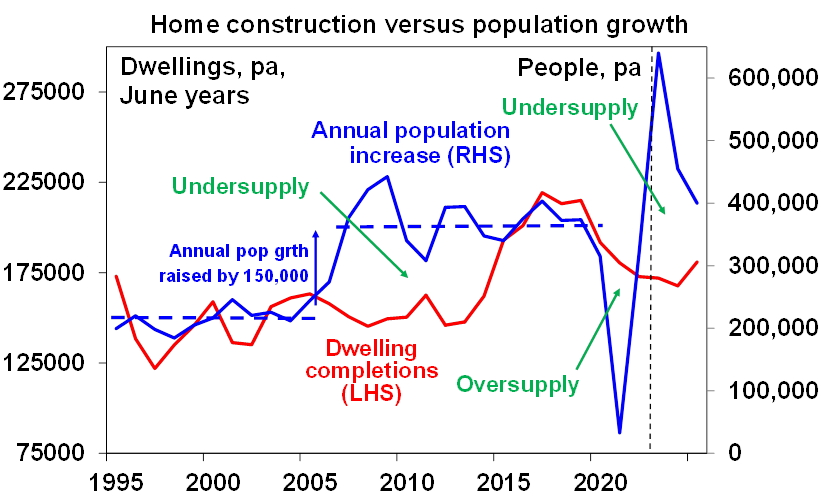 Source: ABS, AMP
Source: ABS, AMP- Finally, the fading strength in the property market is confirmed by a downtrend in auction clearance rates, home lending growth well below peak levels suggesting that the rebound in home prices has come on low volumes (and may lack conviction) and a softening in the upper end of the market in Sydney and Melbourne (which is where downturns often commence).
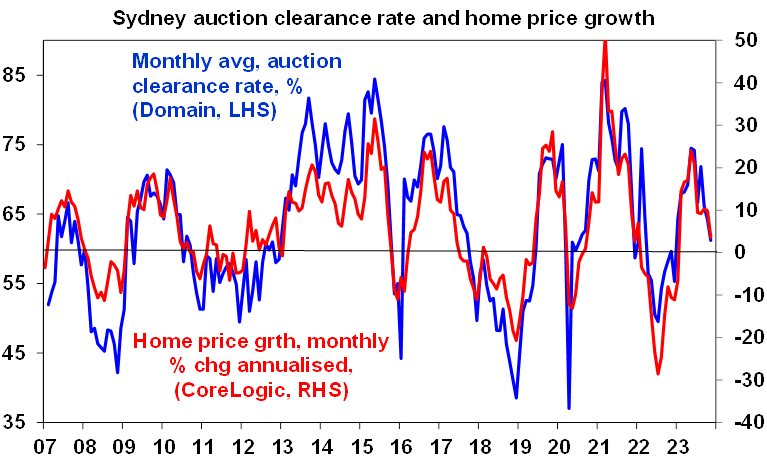 Source: Domain, CoreLogic, AMP
Source: Domain, CoreLogic, AMPPut simply, the combination of slowing home price growth since May (when it peaked at 1.2% month on month) and slowing auction clearance rates from the low to mid 70% range to around 60% suggest that housing demand is struggling to keep up with listings. The supply shortfall in the face of strong demographic demand has had the upper hand this year, but high interest rates and their lagged impact are now starting to reassert themselves. As a result, we are allowing for a double dip fall in national average property prices and are allowing for a 5% fall next year.
Of course, there is likely to be a big range around this with Sydney and Melbourne more at risk given higher debt levels but Adelaide, Brisbane and Perth likely to remain relatively stronger with lower listings and a benefit from interstate migration.
The ongoing housing shortage is likely to limit falls, but a deep recession that pushes unemployment up sharply causing a sharp increase in distressed mortgages could offset this pushing prices below their January low.
Our base case is that the start of rate cuts in the second half of next year should help prices bottom and then start to rise again by the end of the year.